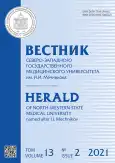Paraneoplastic neurological syndrome in onset of Hodgkin lymphoma
- Authors: Pavlyuchenko E.S.1, Mirsaitov A.A.1, Diakonova M.N.1, Karev E.A.1
-
Affiliations:
- North-Western State Medical University named after I.I. Mechnikov
- Issue: Vol 13, No 2 (2021)
- Pages: 77-82
- Section: Case report
- URL: https://journals.rcsi.science/vszgmu/article/view/60133
- DOI: https://doi.org/10.17816/mechnikov60133
- ID: 60133
Cite item
Abstract
Hodgkin lymphoma is a malignant disease with clonal proliferation of B-cells and high-level reactive inflammatory microenvironment. The main clinical sings are lymphadenopathy and toxic symptoms. Neurological symptoms as usual can be a result of compression or tumor infiltration of nervous structures. The primary damage of CNS occurs from 0,2% to 0,5% of all cases HL.
Paraneoplastic neurological syndrome is a group of rare (an average 1 case on 10000 patients) neurological disorders against the background of oncological process. The pathophysiologic mechanism is due to production of antibody which is both to tumor cells and nerve cells. These antibodies are called onconeural autoantibodies. The hallmark which make diagnostics harder is the fact that onconeural autoantibodies rare take place in patients with lymphomas unless anti-Tr and anti-mGluR1 in patients with limbic encephalitis or paraneoplastic cerebellar degeneration.
There are two case reports about patients with PNS in onset of Hodgkin lymphoma in article.
Keywords
Full Text
##article.viewOnOriginalSite##About the authors
Elena S. Pavlyuchenko
North-Western State Medical University named after I.I. Mechnikov
Author for correspondence.
Email: Elena.Pavlyuchenko@szgmu.ru
SPIN-code: 7123-1626
Russian Federation, 41 Kirochnaya str., Saint Petersburg, 191015
Alexander A. Mirsaitov
North-Western State Medical University named after I.I. Mechnikov
Email: aleksandr.mirsaitov@gmail.com
SPIN-code: 7708-5592
Russian Federation, 41 Kirochnaya str., Saint Petersburg, 191015
Mariya N. Diakonova
North-Western State Medical University named after I.I. Mechnikov
Email: dec.dmn@gmail.com
Russian Federation, 41 Kirochnaya str., Saint Petersburg, 191015
Egor A. Karev
North-Western State Medical University named after I.I. Mechnikov
Email: Egor.Karev@klinikum-lippe.de
Germany, 41 Kirochnaya str., Saint Petersburg, 191015
References
- Rossiiskie klinicheskie rekomendatsii po diagnostike i leche¬niyu limfoproliferativnykh zabolevanii. Ed. by I.V. Poddubnaya, V.G. Savchenko. Moscow: Media Medika; 2013. (In Russ.)
- Demina EA. Hodgkin’s lymphoma: since Thomas Hodgkin up to modern days. Clinical Oncohematology. 2008;1(2):114–118. (In Russ.)
- Al’-Radi LS, Baryakh EA, Belousova IEh, et al. Klinicheskie rekomendatsii po diagnostike i lecheniyu limfoproliferativnykh zabolevanii. Moscow; 2014. (In Russ.)
- Rumyantsev AG, Myakova NV, Maschan AA. Federal guidelines for the diagnosis and treatment of Hodgkin’s lymphoma (Lymphogranulomatosis). Russian Journal of Pediatric Hematology аnd Oncology. 2015;2(4):79–90. (In Russ.). doi: 10.17650/2311-1267-2015-2-4-79-90
- Gerstner ER, Abrey LE, Schiff D, et al. CNS Hodgkin lymphoma. Blood. 2008;112(5):1658–1661. doi: 10.1182/blood-2008-04-151563
- Valiev TT, Guseva NA, Solozhentseva KD. Clinical profile and differential diagnosis of classical paraneoplastic neurologic syndromes in lymphomas. Onkopediatria. 2017;4(3):183–191. (In Russ.). doi: 10.15690/onco.v4i3.1749
- Graus F, Ariño H, Dalmau J. Paraneoplastic neurological syndromes in Hodgkin and non-Hodgkin lymphomas. Blood. 2014;123(21):3230–3238. doi: 10.1182/blood-2014-03-537506
- Shnayder NA, Dykhno YuA, Ezhikova VV. Clinical heterogeneity of paraneoplastic neurological syndrome. Siberian Journal of Oncology. 2011;(3):82–90. (In Russ.)
- Davydovskaya MV, Boĭko AN, Beliaeva IA, et al. Autoimmune encephalitis. S.S. Korsakov Journal of Neurology and Psychiatry. 2015;115(4):95–101. (In Russ.). doi: 10.17116/jnevro20151154195-101
- Tandra PK, Kallam A, Bendi VS, et al. Paraneoplastic manifestations of lymphoproliferative neoplasms. Lymphoma and Chronic Lymphocytic Leukemias. 2016;(6):21–33. doi: 10.4137/LCLL.S38507
- Krasnov MYu, Pavlov EV, Ershova MV, et al. The range of neurological syndromes associated with glutamic acid decar¬boxylase antibodies. Annals of Clinical and Experimental Neurology. 2015;9(4):37–41. (In Russ.)
Supplementary files









